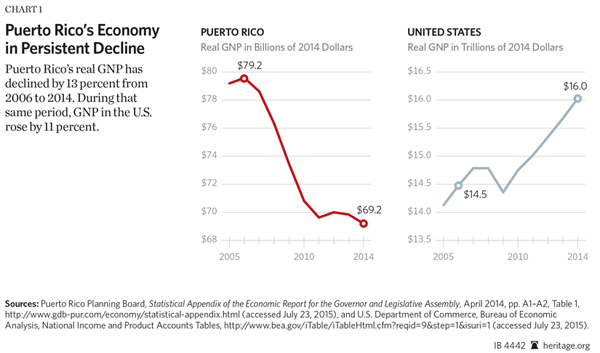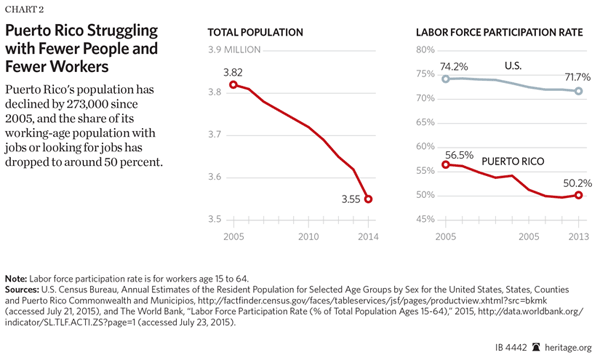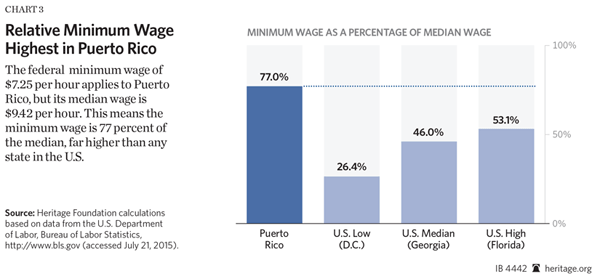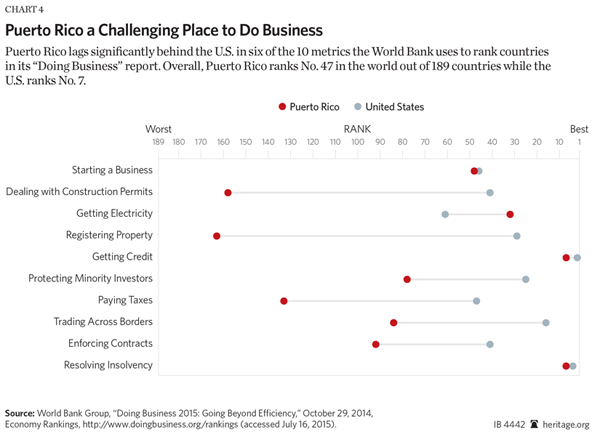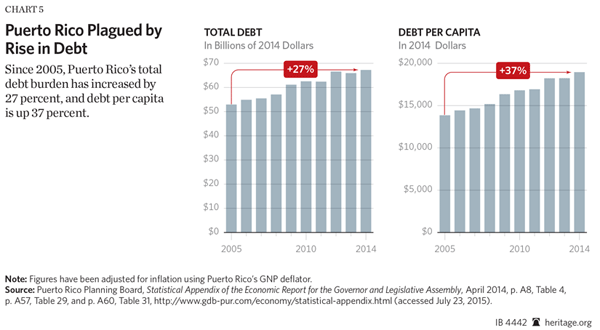Puerto Rico faces a severe fiscal crisis, but this is merely a symptom of Puerto Rico’s primary disease: a lack of economic growth. Over the past decade, as Puerto Rico’s debt has expanded rapidly, the economy has contracted more than 10 percent. If the economy were growing, Puerto Rico would be much better positioned to address its fiscal crisis and might have averted it altogether.
At $72 billion, Puerto Rico’s debt is now more than 100 percent of its gross national product (GNP). The debt does not include another $35 billion in unfunded pension liabilities and other unfunded liabilities, which also need to be considered. Confronting this massive debt will require difficult political decisions.
Creditors who took the risk of lending to the Puerto Rican government will most likely suffer financial losses. Yet even wiping Puerto Rico’s debt slate clean would not solve the island’s problems. The only way to bring about lasting fiscal stability in Puerto Rico is to address the island’s declining economy. Puerto Rico will not emerge from its economic or fiscal woes without the proper foundations for growth, such as a robust labor market, an attractive business climate, a non-stifling regulatory regime, and less cronyism and corruption.[1] Stopgap proposals, such as extending Chapter 9 bankruptcy to Puerto Rico’s municipalities and utility companies, also will fail to produce long-term financial stability.[2]
Declining Economy
Puerto Rico is not experiencing a temporary recession; it is in economic decline. Puerto Rico’s real GNP has declined in seven of the past eight years, with only a slight increase in 2012.[3] Real GNP in Puerto Rico fell 13 percent from its peak from 2006 to 2014. During this period, despite its own recession, GNP increased in the U.S. by almost 11 percent.[4] (See Chart 1.)
Shrinking Population and Labor Force
Without economic growth, Puerto Ricans are fleeing the island for better opportunities. The island’s population has declined by more than 250,000 (7 percent) over the past decade.[5] (See Chart 2.)
Making matters worse is a decline in labor force participation (LFP) among the island’s remaining residents. In 2013, only 50.2 percent of Puerto Rico’s working-age population (ages 15–64) participated in the labor force, compared with 71.7 percent in the U.S.[6] The gap between Puerto Rico’s LFP rate and the U.S. rate amounts to more than 500,000 people, or 22 percent of Puerto Rico’s working-age population.
Puerto Rico’s reported LFP rate and total employment figures likely understate the true values because Puerto Rico has a significant underground labor market that does not pay taxes. A relatively high minimum wage and strict labor laws contribute to the underground economy by driving up the costs of formal employment. (See Chart 3.) For many workers, “off-the-books” jobs are either the only or the preferable option.
The U.S. minimum wage of $7.25 applies to Puerto Rico. In Puerto Rico, however, that minimum is equivalent to 77 percent of the median wage. In most states, the minimum wage is between 40 percent and 50 percent of the median.[7]
If the federal minimum wage were not burden enough, Puerto Rico adds its own costly employment requirements such as mandatory Christmas bonuses (“el Bono de Navidad”); inability to fire employees at will without significant severance pay; and mandatory paid leave including 15 vacation days, 12 sick days, eight weeks of maternity leave, and one hour per day for breastfeeding.[8]
Doing Business
High employee costs and regulations are not the only problems confronting employers. According to the World Bank Group’s Doing Business rankings, it is significantly more difficult to do business in Puerto Rico than on the U.S. mainland. (See Chart 4.) The U.S. is ranked seventh out of 189 countries for ease of doing business in 2015, while Puerto Rico is ranked 47th.[9] And the business climate in Puerto Rico has been growing worse, not better. It was ranked 41st in 2014.
Among the factors weighing down Puerto Rico’s business climate are difficulties registering property (Puerto Rico ranked 163rd); dealing with construction permits (158th); paying taxes (133rd); and enforcing contracts (92nd).[10] That means that inefficient government bureaucracy is significantly retarding growth. Improvement in these basic government services would allow more opportunities for both investors and employees in Puerto Rico.
Puerto Rico scored low on trading across borders (84th) thanks to numerous bureaucratic requirements, and its trade is also limited by the federal Jones Act of 1920. The Jones Act limits economic growth in Puerto Rico by significantly raising the cost of shipping between Puerto Rico and the mainland.[11]
Debt
From 2005 to 2014, real Puerto Rican government debt per capita increased from about $13,900 to almost $19,000 (37 percent).[12] (See Chart 5.) Debt will continue to rise because the island’s $72 billion in debt does not include roughly $35 billion in unfunded pension liabilities, which will soon affect the island’s budgets and further increase the debt.
Tax Increases Are Not Working
Puerto Rico has turned to tax increases to alleviate its debt problems. (See Chart 6.) In March, the island government raised the import tariff on crude oil by 68 percent, from $9.25 per barrel to $15.50 per barrel.[13] In May, the government raised the sales tax from 7.0 percent to 11.5 percent—a 64 percent hike.[14] The tax increases will do more harm than good in an already declining economy. Rather than raising taxes, Puerto Rico should seek to boost economic growth, which in turn would drive up tax revenues.
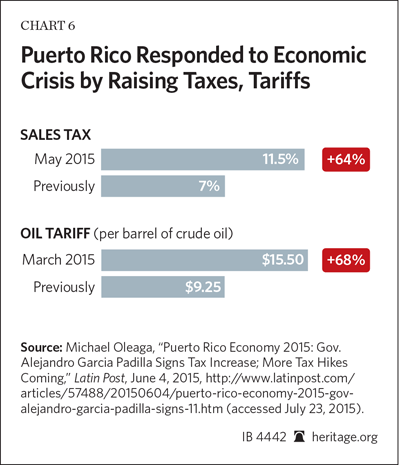
Conclusion
Puerto Rico’s problems are much larger than its $72 billion of debt. As the situation in Greece has shown, economic growth is necessary for fiscal sustainability. Although Congress can do a few things to stimulate economic growth, such as freeing the island from Jones Act shipping restrictions and the federal minimum wage, Puerto Rico needs to do its part to retain and attract businesses and people by making it easier to employ workers and by reducing regulatory and tax burdens. Without an economic turnaround, Puerto Rico will never become fiscally stable.
—Rachel Greszler is Senior Policy Analyst in Economics and Entitlements and Salim Furth, PhD, is Research Fellow in Macroeconomics in the Center for Data Analysis, of the Institute for Economic Freedom and Opportunity, at The Heritage Foundation.
